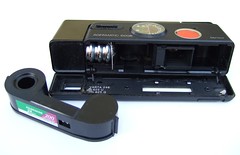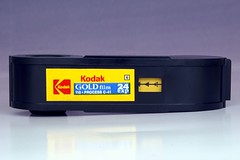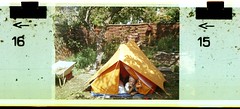Difference between revisions of "110 film"
(swapped some pictures missing required clickthrough to Flickr; +rights & attributions) |
|||
| Line 1: | Line 1: | ||
''See the [[:Category: 110 film]].'' | ''See the [[:Category: 110 film]].'' | ||
{{Flickr_image | {{Flickr_image | ||
| − | |image_source= http://www.flickr.com/photos/89864432@N00/2076627318/in/pool- | + | |image_source= http://www.flickr.com/photos/89864432@N00/2076627318/in/pool-camerawiki |
|image= http://farm3.static.flickr.com/2115/2076627318_8b35a2692f_m.jpg | |image= http://farm3.static.flickr.com/2115/2076627318_8b35a2692f_m.jpg | ||
|image_align= right | |image_align= right | ||
|image_text= Typical 110 cartridge & loading slot,<br>on an [[Agfamatic 6008 makro pocket sensor|Agfamatic 6008]] | |image_text= Typical 110 cartridge & loading slot,<br>on an [[Agfamatic 6008 makro pocket sensor|Agfamatic 6008]] | ||
| + | |image_by=Uwe Kulick | ||
| + | |image_rights= with permission | ||
}} | }} | ||
110 and [[126 film]] cartridges were launched by [[Kodak]] in answer to consumer complaints about the complications involved with loading and unloading roll film cameras. With the cartridge film you don't have to attach the film leader to a take-up spool and cannot go wrong. The cartridge simply drops into the camera, you close the camera's back door, wind on and shoot. Even if you open the camera with a half exposed film inside, the precious exposed film is well protected inside the cartridge. And at the end of the film, you don't have to rewind. | 110 and [[126 film]] cartridges were launched by [[Kodak]] in answer to consumer complaints about the complications involved with loading and unloading roll film cameras. With the cartridge film you don't have to attach the film leader to a take-up spool and cannot go wrong. The cartridge simply drops into the camera, you close the camera's back door, wind on and shoot. Even if you open the camera with a half exposed film inside, the precious exposed film is well protected inside the cartridge. And at the end of the film, you don't have to rewind. | ||
| Line 11: | Line 13: | ||
{{Flickr_image | {{Flickr_image | ||
| − | |image_source= http://www.flickr.com/photos/49656291@N00/3964278280/in/pool- | + | |image_source= http://www.flickr.com/photos/49656291@N00/3964278280/in/pool-camerawiki |
|image= http://farm3.static.flickr.com/2653/3964278280_f5d6de4347_m.jpg | |image= http://farm3.static.flickr.com/2653/3964278280_f5d6de4347_m.jpg | ||
|image_align= right | |image_align= right | ||
|image_text= 110 cartridge label & frame number window | |image_text= 110 cartridge label & frame number window | ||
|image_by=Kenneth Dwain Harrelson | |image_by=Kenneth Dwain Harrelson | ||
| + | |image_rights=with permission | ||
}} | }} | ||
The 110 cartridge contains 16mm wide film, with one perforation at each frame which engaged with a pin beside the film gate to control the [[film advance]]. Like [[126 film|126]], 110 film is pre-exposed with a border and frame number between the frames. The film is paper-backed; the paper being printed with frame numbers, visible through a small window in the cartridge's rear; a larger window in the film chamber door shows this frame number window plus a label on back of the cartridge giving film details. | The 110 cartridge contains 16mm wide film, with one perforation at each frame which engaged with a pin beside the film gate to control the [[film advance]]. Like [[126 film|126]], 110 film is pre-exposed with a border and frame number between the frames. The film is paper-backed; the paper being printed with frame numbers, visible through a small window in the cartridge's rear; a larger window in the film chamber door shows this frame number window plus a label on back of the cartridge giving film details. | ||
| Line 24: | Line 27: | ||
|image= http://farm6.static.flickr.com/5169/5376146386_94e4f44b9b_m.jpg | |image= http://farm6.static.flickr.com/5169/5376146386_94e4f44b9b_m.jpg | ||
|image_align= right | |image_align= right | ||
| − | |image_text= Scan of a 110 frame (Negative Inverted) showing the<br/>sprocket holes and frame number markings | + | |image_text= Scan of a 110 frame (Negative Inverted) showing the<br/>sprocket holes and frame number markings |
| + | |image_by= by Martin Paling | ||
| + | |image_rights= | ||
}} | }} | ||
As the majority of [[:Category: 110 film|110 cameras]] were extremely simple with a single shutter speed and aperture setting and no focusing available, the success of getting prints from these tiny 13x17mm negatives relied on the latitude of the film. Even with today's modern film emulsions and an accurate focusing and exposure mechanism it would be tough to get much more than a 5×7in print from such a tiny negative. Disappointing print results were the main downfall of the format. | As the majority of [[:Category: 110 film|110 cameras]] were extremely simple with a single shutter speed and aperture setting and no focusing available, the success of getting prints from these tiny 13x17mm negatives relied on the latitude of the film. Even with today's modern film emulsions and an accurate focusing and exposure mechanism it would be tough to get much more than a 5×7in print from such a tiny negative. Disappointing print results were the main downfall of the format. | ||
| Line 30: | Line 35: | ||
Kodak stopped making 110 cameras around 1994<ref name="Kodak" />, with few other manufacturers' 110 ranges lasting any longer. 110 film continued to be made by [[Fuji]] until c.2004, and by [[Kodak]] and [[Ferrania]] for a few years more. The outdated films and cameras are still available today but not easily in the American marketplace. | Kodak stopped making 110 cameras around 1994<ref name="Kodak" />, with few other manufacturers' 110 ranges lasting any longer. 110 film continued to be made by [[Fuji]] until c.2004, and by [[Kodak]] and [[Ferrania]] for a few years more. The outdated films and cameras are still available today but not easily in the American marketplace. | ||
| − | + | {{Flickr_image | |
| − | { | + | |image_source= http://www.flickr.com/photos/artysmokes/3358239644/in/pool-camerapedia |
| − | | | + | |image= http://farm4.static.flickr.com/3606/3358239644_0e39d1fcab_m.jpg |
| − | + | |image_align= left | |
| − | | | + | |image_text= AA Autolite Powerdrive |
| − | || | + | |image_by= Arty Smokes |
| − | || | + | |image_rights= non-commercial |
| − | |} | + | }} |
| − | + | {{Flickr_image | |
| + | |image_source= http://www.flickr.com/photos/hillarystein/5172762870/in/pool-camerawiki | ||
| + | |image= http://farm5.static.flickr.com/4131/5172762870_535923dc17_m.jpg | ||
| + | |image_align= left | ||
| + | |image_text=Kraft Velveeta promotional camera | ||
| + | |image_by= Hillary Stein | ||
| + | |image_rights= non-commercial | ||
| + | }} | ||
| + | {{br}} | ||
| + | ==References== | ||
<references /> | <references /> | ||
| + | |||
== Links == | == Links == | ||
Revision as of 03:32, 16 April 2011
See the Category: 110 film.

|
| Typical 110 cartridge & loading slot, on an Agfamatic 6008 image by Uwe Kulick (Image rights) |
110 and 126 film cartridges were launched by Kodak in answer to consumer complaints about the complications involved with loading and unloading roll film cameras. With the cartridge film you don't have to attach the film leader to a take-up spool and cannot go wrong. The cartridge simply drops into the camera, you close the camera's back door, wind on and shoot. Even if you open the camera with a half exposed film inside, the precious exposed film is well protected inside the cartridge. And at the end of the film, you don't have to rewind.
After the success of Kodak's 126 cartridge "Instamatic" cameras, 110 was introduced in 1972[1] to take advantage of improvements in film allowing smaller format negatives. The first Kodak cameras being branded "Pocket Instamatic".

|
| 110 cartridge label & frame number window image by Kenneth Dwain Harrelson (Image rights) |
The 110 cartridge contains 16mm wide film, with one perforation at each frame which engaged with a pin beside the film gate to control the film advance. Like 126, 110 film is pre-exposed with a border and frame number between the frames. The film is paper-backed; the paper being printed with frame numbers, visible through a small window in the cartridge's rear; a larger window in the film chamber door shows this frame number window plus a label on back of the cartridge giving film details.
The small dimensions allowed designers to create small pocketable camera that had an aspect very different from the traditional 35mm cameras, even if they had a marked resemblance with the older sub miniature 16mm cameras. The pocketability and ease of loading made 110 popular very quickly. The design of the cartridges had a very basic system of notches in a tab on the end to indicate film speed, but few cameras took advantage of this, and many film cartridges did not even have the required notches.

|
| Scan of a 110 frame (Negative Inverted) showing the sprocket holes and frame number markings image by by Martin Paling |
As the majority of 110 cameras were extremely simple with a single shutter speed and aperture setting and no focusing available, the success of getting prints from these tiny 13x17mm negatives relied on the latitude of the film. Even with today's modern film emulsions and an accurate focusing and exposure mechanism it would be tough to get much more than a 5×7in print from such a tiny negative. Disappointing print results were the main downfall of the format.
Kodak stopped making 110 cameras around 1994[1], with few other manufacturers' 110 ranges lasting any longer. 110 film continued to be made by Fuji until c.2004, and by Kodak and Ferrania for a few years more. The outdated films and cameras are still available today but not easily in the American marketplace.

|
| AA Autolite Powerdrive image by Arty Smokes (Image rights) |

|
| Kraft Velveeta promotional camera image by Hillary Stein (Image rights) |
References
Links
- Make your own 110 film slitter
- Splitting Film
- Reloading 110 Cassettes
- Reloading 110 Cartridges
- 110 film still available at the frugal photographer
- picture gallery using 110 film camera
- Micro 110 page at Collection G. Even's site
- Special 110 cameras at Collection G. Even's site
- Various 110 cameras at Collection G. Even's site
- Picture Gallery using a plastic promotional 110 camera